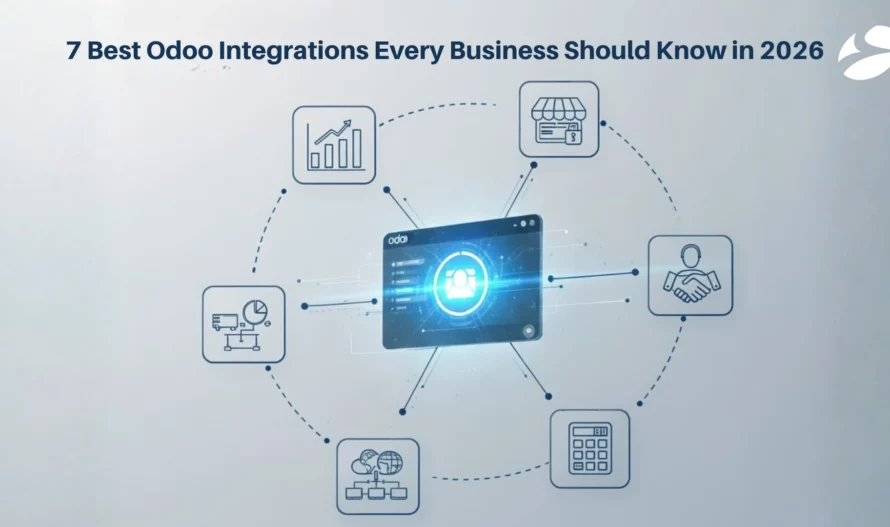326
7 Best Odoo Integrations for Business Growth 2026
29 Apr, 2025
5 min read

You know what will be changed in 2026? It’s not going to be about whether your company has an ERP anymore—everyone does. The real question is: how well does it actually talk to your other systems?
We’ve been working with Odoo implementations for years now, and here’s what we’ve noticed: Odoo’s modular setup is brilliant, but it’s the integrations that really make companies sit up and take notice.
Think of it like this—your ERP is the brain, but integrations are the nervous system connecting everything from your CRM to accounting to that eCommerce store keeping you up at night.
Let us walk you through the seven integrations that are genuinely moving the needle for businesses right now. (And yes, this article will show how the best Odoo Integration services create smarter, region-aware ERP systems across retail, logistics, manufacturing, and finance.)
eCommerce in 2026 is no longer just a side project. It’s where your customers live. I’ve seen companies running Shopify, WooCommerce, or Magento finally breathe easy once they connect these platforms with Odoo.
How does this help? Odoo updates stock, creates the invoice, and schedules deliveries by itself. Which means, no frantic morning emails and no “wait, did we actually have that in inventory?” moment. Just simplified and streamlined processes powered by automation.
Here, one thing that we would advice is that you should sync your SKUs between Odoo and your store first. Doing it backward creates a data mess that you do not want to spend time cleaning up.
Here, someone always asks: “What about regional pricing? Can we push GCC rates versus European pricing automatically from Odoo?”
Absolutely. With localization rules and proper API mapping, the best Odoo integration handles region-specific pricing and tax compliance—whether that’s UAE VAT or EU VAT—without you manually updating hundreds of products.
Why does this matter? Companies report witnessing order-to-delivery cycles operating at nearly double the speed, with the eCommerce and Odoo backends functioning as a single unit. That’s not just efficiency—that’s competitive advantage.
Whether you’re processing transactions in Dubai or Calgary, payment processing can’t feel clunky. Your customers won’t forgive it.
Integrating Odoo with gateways like Stripe, PayTabs, Razorpay, or PayPal means every invoice automatically syncs with payment status. Your accounting team stops doing manual reconciliations across currencies, and everyone goes home earlier.
But here’s where it gets really interesting: this best Odoo integration doesn’t just save time—it keeps you compliant. A client in Riyadh completes a payment? Odoo instantly generates a ZATCA-compliant e-invoice. Audit time becomes less stressful. With Odoo CRM Integration, customer data flows seamlessly into your financial and sales processes, ensuring that everything stays organized and aligned for maximum efficiency.
Odoo Consultant Tip: Set your multi-currency rounding rules before activating payment sync. This way, when multiple currencies do get involved in the process, it doesn’t turn growth into unmanageable chaos.
Look, Odoo’s native CRM is solid. But plenty of enterprises use Salesforce, HubSpot, or Zoho for specific regions or teams. That’s reality.
Instead of fighting it, integrate them. You get that complete 360° view everyone talks about but rarely achieves—leads, sales, deliveries, and invoices all connected in one customer journey.
Someone recently asked us: “Can Salesforce opportunities automatically become Odoo quotations?”
Yes. Using the best Odoo integration mapping, opportunities in Salesforce flow directly into Odoo quotations, bringing customer records, pricing, and lead history along for the ride.
What you do need to keep in mind is standardization. Make sure that field names do not imply different meanings on Salesforce and Odoo. For example, the field name “Company Name” should denote the same thing for both platforms. If not taken care of, it will break the automation flow.
The payoff? Teams using integrated CRM and Odoo pipelines witness an upward-moving graph in lead-to-order conversion rates. That’s more closed deals from the same effort.
Everyone uses some sort of digital accounting platform. Tools like QuickBooks, Zoho Books, or Xero are familiar to many. But the issue is not using them; it is data isolation. Lack of proper data flow implies more manual efforts in ledger maintenance.
Integrate Odoo with these platforms, and it will eliminate this issue of data silos. It will bring invoices, vendor bills, payments, and everything else into one unified ledger. Doing so will ensure transparency, reduce manual efforts, and also mitigate compliance risks.
For companies in the UAE or KSA, this best Odoo integration is honestly a game-changer. It supports VAT-ready reporting, ZATCA Phase 2 e-invoicing, and dual-currency accounting—no Excel gymnastics required.
Word to the wise: Define your tax tags (UAE VAT, KSA VAT, India GST) before importing data. Fixing it afterward is… well, let’s just say you don’t want to do it.
“Can we maintain a shared chart of accounts across subsidiaries?” It is a frequent question from our client. And the answer to that is, yes—Odoo’s multi-company architecture lets you share or separate CoAs while still getting consolidated reporting.
Odoo helps manufacturers and distributors streamline their logistics processes. Odoo can be integrated with shipping APIs like FedEx, Aramex, DHL, or ShipStation and automate the entire delivery management journey. API calls manage everything from order confirmation to shipment and label generation to order tracking.
This improves the company’s reputation and reduces dispatch delays. A lot of business owners say, this is good, but can Odoo calculate delivery rates on the fly?
It can. The best Odoo integration determines shipping rates based on multiple factors like package weight, destination, carrier agreements, etc., in real time. With Odoo CRM Integration, customer details are automatically synced, ensuring that the system can calculate shipping costs based on their location and preferences. The customer gets to see the dynamic shift in the price based on their input: no surprises or inaccurate shipping estimates.
You can test the rate APIs in sandbox mode first—especially if you’re navigating GCC customs tariffs. Production is not the place to discover pricing issues.
Impact? Integrated logistics can reduce stockouts by 92% within three months because you finally have real-time visibility across fulfillment centers.
Remote and hybrid work isn’t going anywhere now, but companies are still skeptical about it. Why? Multiple systems and working locations create the perfect opportunity for communication gaps to take root.
But with Odoo, numerous systems like Slack, Microsoft Teams, or Google Workspace come together into one consolidated Odoo dashboard. This means everyone gets the clarity and contextual understanding and proceeds accordingly.
When you integrate Odoo with Slack, Microsoft Teams, or Google Workspace implies your team collaborates with clarity and contextual understanding. It will convert the sales inquiry on Slack into a lead in Odoo. And, support updates sync back to Teams.
That’s the essence of the best Odoo integration—meeting people where they already are. Before integration, decide which modules trigger chat notifications. Too many, and you’ve just replaced silence with noise.
“Can our operations team see project updates directly in Teams?”
Yep. Through Odoo’s Teams connector, project milestones and timesheets push as adaptive cards. Your team stays informed without switching contexts. An integrated workflow significantly accelerates the task resolution and reduces internal escalations by almost half.
Five years ago, if you had said that data storytelling would be the key competitive differentiator, everyone would’ve gone like, oh yeah, sure. But today, data is the key to unlocking business growth, opportunities, and understanding the target audience.
What Odoo does here is it connects with BI tools like Power BI, Tableau, or Google Data Studio, and allows the leaders to get a complete picture of their business processes and their market standing. From revenue heatmaps to real-time sales forecasts, they get to witness a complete picture.
Why is this the best Odoo integration? It replaces exported CSVs with live dashboard updates. The key to a streamlined process is to use Odoo’s built-in API filters to ensure only clean, validated data reaches BI tools.
Some business owners ask, “Can we build dashboards for different departments?”
Yes, Odoo’s flexible architecture allows that. How will it take shape in an actual business model? Say your CFO monitors profit margins, while your COO tracks fulfillment efficiency. Both of them will utilize the same live dataset, but the data will be filtered to provide a clean, uninterrupted view of what matters to them.
Odoo is not just an ERP anymore. It’s the orchestration layer of how modern businesses actually operate. But the real ROI? That comes from integration—where your data, compliance requirements, and customer experience all meet.
The best Odoo integration doesn’t just connect apps. It aligns departments, ensures compliance across geographies, and builds the kind of digital resilience that lets you scale confidently.
At BiztechCS, we’ve helped enterprises across the UAE, Saudi Arabia, India, and North America bridge exactly these gaps. We architect modular, future-ready Odoo ecosystems that connect commerce, finance, and operations into one fluid system.
If your teams are still doing manual reconciliations or staring at fragmented dashboards, something needs to change. Your competitors aren’t waiting—why should you?
Let’s map out your Odoo integration roadmap together—module by module, region by region.

Artificial Intelligence (AI)
38
By Biztech Editor
24 Dec, 2025

Odoo
41
By Uttam Jain
24 Dec, 2025

Artificial Intelligence (AI)
47
By Biztech Editor
23 Dec, 2025